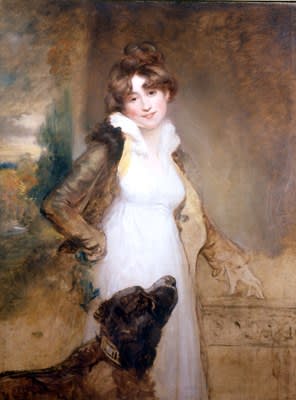
Arthur William Devis
To view all current artworks for sale visit philipmould.com
This rare, unfinished, portrait is one of the most evocative examples of Devis’ Regency period portraiture. The flowing contours and elegant characterisation are demonstrative of the neo-classical influence of Reynolds, while the romantic pose and background, and the fact that it is unfinished, all combine to give the painting a fluidity that borders on the contemporary. This is a work that transcends the normal parameters of eighteenth and nineteenth century portraiture, and it is no surprise that a painting which captures the female character as successfully as a Renoir or Degas should have found a prominent place in the collection of Camille Groult, the famous French collector whose works can now be found in museums worldwide.
Arthur William Devis’ life was as a colourful as his paintings. As the son of the celebrated portraitist and painter of conversation pieces, Arthur Devis, it seemed an artistic career was obvious. His father’s influence could be seen in his work from the outset, especially in the attention to detail of drapery and costume. But Devis’ capacity to capture fluid and relaxed poses, even in animals – a product of the training he enjoyed at the Royal Academy in the 1770s under the gaze of Reynolds – was in marked contrast to his father, and it is this that establishes him as one of the most talented British artists of the early nineteenth century. Devis’ Death of Nelson (1805-7, National Maritime Museum), for example, has become the definitive image of Nelson’s heroic end, while his portraits were described as ‘the wonder of the saleroom’ when bought by Lord Duveen in the 1930s.
Devis’ early career began in earnest in India in the 1780s, where, like Zoffany, he hoped his talent would make his fortune. At first, successful commissions such as Warren Hastings appeared to herald his future prosperity. But Devis’ career is a stark example of how talent alone is not enough to guarantee success. Although he had the undoubted skill to compete with contemporaries such as Hickey in India (and even Lawrence after his return to London in 1795) Devis’ complete inability to manage his financial affairs rendered him unable to receive enough of the society commissions that he deserved. He was, simply, hopeless with money, and was declared bankrupt in 1800, though towards the end of his career he at last began to receive Royal patronage. He left his wife and young children penniless following his sudden death in 1822. This unfinished painting – apparently the only surviving example – is a tangible reminder of the tragic end to his career, and gives us an insight into Devis’ working practice; in the sitter’s right hand we can observe the assured draughtsmanship typical of a pupil of the Academy, while the sketchy background and costume display all the confidence of an artist in complete control of his brush. The large dog in this portrait is identical to that in Devis’ portrait of Thomas Tristram Hodges, and it is possible that the sitter is a member of the same family.
Provenance
Collection Camille Groult, Paris